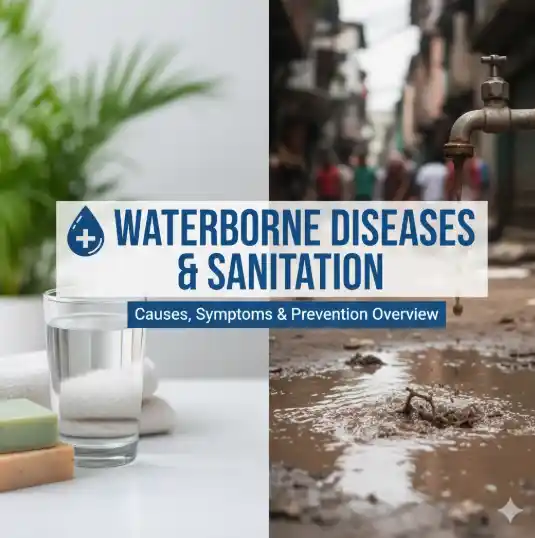Waterborne diseases are illnesses caused by drinking or coming into contact with contaminated water containing harmful microorganisms such as bacteria, viruses, or parasites. These diseases often lead to diarrhea, vomiting, fever, and dehydration, posing a major risk to public health. According to WHO and UNICEF, waterborne diseases remain one of the leading causes of death worldwide, especially in children under five. Around 1.4 million deaths occur annually due to diarrheal diseases, most of which are linked to unsafe drinking water and poor sanitation.
In Pakistan, over 40% of deaths are related to contaminated water, and an estimated 53,000 children die each year due to diarrhea and other waterborne illnesses. Lack of clean water, poor sanitation infrastructure, and seasonal floods make the situation worse. This makes waterborne diseases not just a medical issue but a serious public health challenge that requires urgent attention, including improved sanitation, hygiene practices, and access to safe drinking water for communities.
For more insights into sustainable living and global health topics, you can explore Leatheling’s blog and related health coverage.
Top Waterborne Diseases and Their Impact on Public Health
Waterborne diseases are among the biggest threats to public health, especially in developing countries where access to clean drinking water is limited. Here’s an overview of the most common ones:
Cholera: Fast-Spreading & Deadly
Cause: Vibrio cholerae bacteria in contaminated water or food
Key Symptoms: Severe watery diarrhea, vomiting, rapid dehydration
Impact: Can lead to death within hours if untreated
Prevention: Drink boiled/filtered water, proper handwashing, cholera vaccination in high-risk areas
Typhoid Fever: Silent but Dangerous
Cause: Salmonella typhi bacteria, spread through unsafe water or food
Key Symptoms: High fever, abdominal pain, weakness, rash
Impact: Can damage the intestines and cause life-threatening complications
Prevention: Safe drinking water & good sanitation, typhoid vaccine, and proper washing of fruits & vegetables
If you’re interested in how public health education and infrastructure affect disease prevention, see Understanding the Factors Involved in Globalization: A Comprehensive Guide.
Hepatitis A & E: Viral Liver Infections
Cause: Viruses transmitted via contaminated water (fecal-oral route)
Key Symptoms: Jaundice, nausea, loss of appetite, dark urine
Impact: Can cause acute liver inflammation; dangerous for pregnant women (Hepatitis E)
Prevention: Drink treated water, maintain hand hygiene, get vaccinated for Hepatitis A
Learn more about essential medical measures in Essential Medical Equipment.
Diarrheal Diseases in Children
Cause: Rotavirus, E. coli, and other pathogens from unsafe water
Key Symptoms: Frequent watery stools, dehydration, fever
Impact: The second leading cause of death in children under five globally
Prevention: ORS (Oral Rehydration Solution), Rotavirus vaccine, access to clean water & sanitation
Top Causes of Waterborne Diseases: Unsafe Water, Poor Sanitation & More
Waterborne diseases spread rapidly when water sources are contaminated with harmful microorganisms such as bacteria, viruses, and parasites. Understanding the major causes helps in planning effective prevention strategies.
- Contaminated Water Supply: Unsafe drinking water is the biggest source of waterborne diseases. Contamination occurs when sewage, industrial waste, or animal waste mixes with drinking water sources.
- Poor Sanitation & Open Defecation: Lack of toilets and sewage disposal leads to open defecation, contaminating soil and water sources. WHO reports that improved sanitation could prevent nearly 60% of diarrheal deaths worldwide.
- Lack of Water Treatment Plants: Many communities lack purification systems, resulting in frequent outbreaks.
- Flooding & Natural Disasters: Floods cause sewage overflow, contaminating wells and pipelines, leading to outbreaks.
For deeper insight into environmental impacts, check In What Ways Might Household Saving Rates Reflect the History of a Country, which connects economic and environmental development themes.
Symptoms & Diagnosis of Waterborne Diseases
Early recognition of waterborne diseases is crucial to prevent severe complications and outbreaks.
Common Symptoms:
- Diarrhea
- Vomiting & nausea
- Fever & chills
- Abdominal pain
- Severe dehydration
- Fatigue & weakness
Diagnosis Methods:
- Lab tests (stool culture, blood analysis)
- Rapid diagnostic kits
- Physical examination
- Medical history review
Early detection saves lives and prevents widespread outbreaks. Related reading: High Blood Pressure Management—another major public health issue affected by water and nutrition quality.
Prevention and Control of Waterborne Diseases: Best Practices
Preventing waterborne diseases is possible with simple lifestyle changes and community-level interventions.
Clean Water Practices:
- Use a safe and reliable water source
- Store water in clean, covered containers
- Avoid untreated tap or well water
Boiling & Filtration:
- Boil water for at least 1 minute
- Use ceramic or activated carbon filters
- Disinfect with chlorine or iodine tablets
Personal Hygiene:
- Wash hands with soap before eating and after using the toilet
- Handle food safely
- Dispose of waste properly
If you’re curious about the relationship between hygiene and social structures, check Family Life Cycle Theory: How Families Grow, Change, and Adapt Over Time.
Sanitation and Hygiene Practices That Prevent Waterborne Diseases
Proper sanitation and hygiene are essential for stopping disease spread.
To explore modern sanitation practices and innovations, see Five Surveying, which discusses infrastructure planning and community safety.
Government & NGO Efforts to Improve Sanitation and Access to Clean Water
Efforts from Pakistan’s Clean Drinking Water Program and global NGOs like WaterAid, UNICEF, and WHO are improving community health.
To learn more about impactful development initiatives, check Future Ready Offices in Cyprus, which covers how infrastructure adapts to sustainability goals.
Safe Water and Sanitation: WHO Guidelines and Global Standards
The World Health Organization (WHO) sets global standards for drinking water quality.
Read more official research and data on ScienceDirect and WHO’s official resource.
For an overview of global development goals, see Everything You Need to Know About Leatheling: A Comprehensive Guide to Its Uses, Benefits, and Future Trends.
Impact of Climate Change on Waterborne Disease Outbreaks
Climate change worsens waterborne disease risks through floods, droughts, and rising temperatures.
Learn more about how environmental factors influence global health in Cellulogia and Weight Management — both addressing the intersection of lifestyle, environment, and wellness.
Conclusion
Waterborne diseases remain a major public health challenge worldwide, particularly in developing countries like Pakistan. Contaminated water, poor sanitation, lack of water treatment, and climate-related events contribute to the spread of illnesses such as cholera, typhoid, hepatitis A & E, and diarrheal diseases in children.
Following WHO guidelines and achieving Sustainable Development Goal 6 (Clean Water & Sanitation) can reduce outbreaks by up to 60%. Governments, NGOs, and individuals must collaborate to ensure safe water and healthy communities.Discover more thought-provoking articles and sustainability insights on Leatheling.com.


